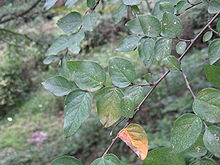Gampi
| Gampi | ||||||||||||
|---|---|---|---|---|---|---|---|---|---|---|---|---|

Terminal inflorescence with four-fold, yellow flowers of Gampi ( Daphne sikokiana ) |
||||||||||||
| Systematics | ||||||||||||
|
||||||||||||
| Scientific name | ||||||||||||
| Daphne sikokiana | ||||||||||||
| ( Franch. & Sav. ) Halda |
Gampi ( Jap. 雁皮 even Ganpi , literally means "goose bumps", or Kami no ki, literally paper tree ) ( Daphne sikokiana ) is a plant from the genus Daphne ( Daphne ) within the family Thymelaeaceae (Thymelaeaceae). It occurs only on the central and western Japanese islands of Honshū , Shikoku and Kyushu (only in Saga Prefecture ). Their fibers are used to make Japanese paper .
description
Appearance and leaf
Gampi grows as a deciduous shrub that usually reaches heights of about 2 (1 to 3) meters. The bark is hairy and silky and brown on older parts of the plant. The branches are spread out.
The alternate leaves arranged on the branches are divided into a petiole and a leaf blade. The petiole is 2 to 3 mm long. The simple, membranous, densely silky hairy leaf blade is egg-shaped with a length of 1.5 to 8 cm and a width of 1 to 4 cm with a wedge-shaped or round base and a pointed to pointed upper end.
Inflorescence, flower and fruit
The flowering period in Japan extends from May to June. The terminal, heady inflorescences contain 7 to 20 flowers. The sessile flowers are hermaphroditic or rarely unisexual and quadruple. The four durable, yellow, corolla-like sepals are fused together to form an 8 mm long calyx tube and the four calyx tips are 2 to 3 mm long. There are two circles with four stamens each. The disc is simple to three-part in the upper area. The densely long hairy pistil about 4 mm long.
The short stalked, with a length of about 6 mm narrowly ovate-spindle-shaped, hard berry-like fruit is hairy and covered by the durable calyx.
Taxonomy
The first description was in 1878 under the name ( Basionym ) Wikstroemia sikokiana Franch. & Sav. by Adrien René Franchet and Paul Amédée Ludovic Savatier in Enumeratio Plantarum in Japonia Sponte Crescentium ... , 2, 2, p. 481. The new combination to Daphne sikokiana (Franch. & Sav.) Halda was made in 1999 by Halda in Acta Musei Richnoviensis , Volume 6, 3, p. 209. Other synonyms for Daphne sikokiana (Franch. & Sav.) Halda are: Wikstroemia canescens var. Pauciflora Franch. et Sav. , Diplomorpha sikokiana (Franch. & Sav.) Honda , Diplomorpha sikokiana (Franch. & Sav.) Nakai . The specific epithet sikokiana refers to the southern Japanese island of Shikoku .
use
Its fine and smooth bast fibers are used to make Japanese paper , which is called Washi in Japan. Harvesting takes place between February and May when the plants are full of water.
swell
- The species in the Flora of Japan . (Section Description and Distribution)
Individual evidence
- ↑ International trivial names in Multilingual Multiscript Plant Name = MMPND.
- ↑ a b c d e The species in the Flora of Japan . ( Page no longer available , search in web archives ) Info: The link was automatically marked as defective. Please check the link according to the instructions and then remove this notice. (Section description)
- ^ Daphne sikokiana at Tropicos.org. Missouri Botanical Garden, St. Louis, accessed May 20, 2013.
- ↑ Entry in Plants for A Future . (English)
- ↑ Washi: Japanese handmade paper .
- ↑ Preparation of the Gampi fibers for paper production ( Memento from May 23, 2006 in the Internet Archive ) (English)
